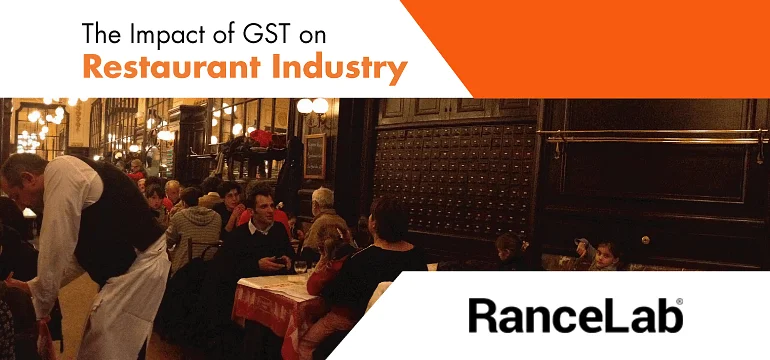With the passing of the GST (Goods and Services Tax) Bill, the nation’s F&B (Food and Beverage) Industry has been left both shaken…and stirred. As a mode of indirect tax, this affects both the manufacturer as well as the consumer. The impact of GST on Restaurant Industry is effectively seen in both categories– those who are working as restaurateurs (restaurant owners, businessmen, investors) as well as those that form part of the clientele (consumers ranging from café hoppers to fine diners).
With the GST coming into force, several state levied taxes like the value-added tax, entertainment tax, sales tax, service tax, purchase tax etc. have all been subsumed into a single unified tax. But how does this affect you?
Benefits expected due to levy of GST on Restaurant Industry
- Restaurants and hotels may improve their overall service as a single tax will be processed at checkout;
- Consumers are finally free from having to haggle their brains calculating various taxes on the final bill;
- Needless to say, with a single tax under GST for restaurants, the payment system is going to be more effective and faster;
- Overall, trading on several commodities that was not regulated earlier has become more structured, for example, oilseeds, pulses and cereals have been put under the light of a structured tax, and therefore can be accessed better in terms of both manufacture and consumption.
Dreading Dining Out? Don’t!

As a layperson, one may be a little more inclined to cut down on several courses at a restaurant because of the high amount of taxes payable on the final bill that is so melodiously dropped on your lap by the waiter at the end of your meal. Instead of ordering dessert, you’ll be scanning the tiny percentage signs on the end of the receipt with a reluctant hand on your wallet.
But are you aware that the GST could be a good thing?
- Instead of scanning several rates of taxes and duties, a customer can actually save a small percentage every time he eats out because of a standard value charged (under the current tax regime this value could come down to 18% on the total value of the bill).
- As a consumer, the GST on restaurant meals has made dining out more pocket-friendly with a single transparent 18% charge as opposed to the earlier multiple 20-24% charges that were cumulatively levied.
Better Days for Biz Owners?
As an owner of a restaurant business, one may be hassled with the several taxes from the purchase of raw materials right till selling the final product to the consumer. How does the GST on Restaurant Industry affect this target market?
Raw materials can be procured at subsidized rates from agriculturists and farmers at a single stroke instead of owners having to negotiate – taxes shall remain uniform throughout states thus making the competition even. The overall cost of procuring goods will thus decrease substantially, making the restaurant business a viable and easily manageable venture again.
But what could go wrong?
- The high cost associated with raw materials multiplies into the bill thrown on the consumer’s lap at the end of the meal, which may discourage people from eating out
- Capital expenditure (investing in capital for the business) could take a hike because of an increase in the procuring cost of capital goods.
- Nonetheless, with a single unified tax rate, restaurant owners can take a sigh of relief as lower taxes may as well attract more consumers.
Also Read: GST Simplified for Restaurants
Bad news for Beverages?

According to the GST Council –
- Aerated drinks come under the highest rate of tax of 28%, as they fall under the ambit of luxury goods;
- These products also attract a cess, therefore posing a disadvantage to these beverages;
Steering towards the alcohol and liquor sector, this area has gotten affected a great extent as vendors and suppliers alike shall be exposed to both GST and non-GST regimes depending on the input/output.
So what’s the good news?
The alcoholic beverage and aerated drinks sector will now see better and more effective channels of distribution. States shall have administrative regulatory powers over the sale of liquor as the product will no longer be controlled by the centre. However, alcohol, on the whole, could take a hit as the tax on the final retail product will be high due to stringent control – thus owing to a fall in demand in the consumer market, as well as an adverse impact on foreign investment in the hospitality sector.
Foreign entrants may be slightly skeptical in investing in restaurants and hotels because of the increase in liquor costs; and overall this may have a damaging impact on the sale prices, therefore placing the customer at a crossroads upon purchase of alcohol. But on the bright side, maybe this is going to help you save your money better every time you think about splurging on a Friday night!
So whether you are a business owner or just someone who enjoys eating out on a regular basis, the GST is here to make a difference. Right from the farmers and their produce, to manufacturers and finally the consumers, the demographic is going to visualize a steady albeit upward move in the right direction – certainly, prima facie unifying a tax is the way ahead across the F&B industry.
But how is the GST practically going to affect you? Only time and expense will tell.
Now FusionResto has been updated to A GST Ready Restaurant Software. Simply your restaurant management & it’s tax calculations with FusionResto. Know More.
Update:
The effective Tax for the food served in Restaurants was around 20.5% (including a 6% Service Tax and 14.5% VAT) + 15% Service Tax before GST, which has now come down to as low as 12% under GST.
GST on Restaurants –
GST in Non-AC restaurants will be charged at 12%, while in AC restaurants it will be charged at 18%. The GST on 5-Star hotel restaurants has been reduced from 28% to 18%, bringing it at par with standalone air-conditioned restaurants. Restaurants with a turnover less than Rs. 50 lakh would be levied a GST rate of 5%.







Leave a Reply
You must be logged in to post a comment.